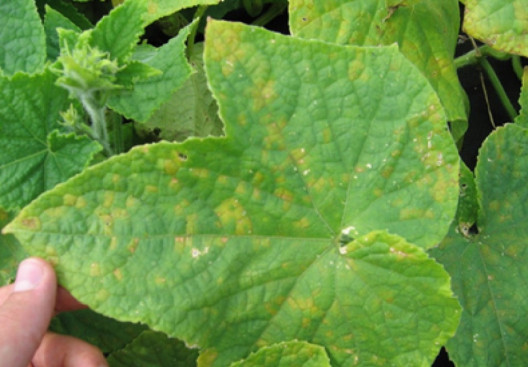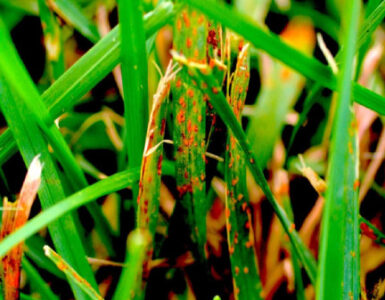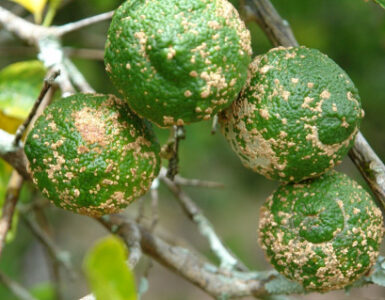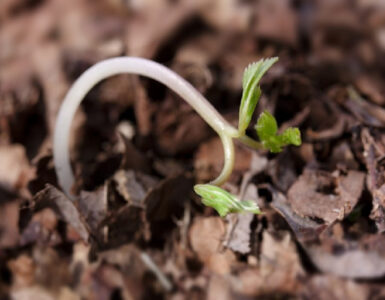Downy mildew is a disease that affects a wide range of plant species.
It can spread quickly under the right conditions. And if left unchecked, it can ruin an entire crop.
Fortunately, there are natural ways to control and prevent downy mildew.
Identification
Downy mildew is a disease caused by oomycetes, also known as water molds [1].
The first sign is often light green to yellow spots on the upper surface of the leaves. You may also notice a white, fluffy growth on the undersides of the leaves.
Downy mildew thrives in cool, humid, and wet conditions. If not handled correctly, it can seriously damage and even kill plants.
Plants That Downy Mildew Affects
As mentioned, downy mildew can affect a wide range of plants.
Cucumbers, squash, lettuce, spinach, basil, onions, and tomato plants are vulnerable. It may also affect crops such as maize, cabbage, peas, buckwheat, and mustard.
Grapevines are another host, with downy mildew posing a threat to vineyards [2]. The disease also affects ornamental plants, such as impatiens and roses.
How to Get Rid of Downy Mildew Naturally
Below are natural ways to help manage and prevent downy mildew.
1. Hydrogen Peroxide Solution
A diluted hydrogen peroxide spray can combat downy mildew.
Mix 3% hydrogen peroxide with water in a 1:9 ratio and apply it to infected leaves. This remedy helps kill mildew spores while being safe for the plants.
2. Promote Good Air Circulation
Good air circulation is a must for preventing downy mildew.
A crowded garden traps moisture, increasing humidity levels. This humidity creates the perfect conditions for the disease to thrive.
Therefore, if plants grow too close, thin them out by removing weaker or excess plants.
3. Eliminate Weeds
Regularly removing weeds also reduces the chances of infection by improving airflow.
4. Prune Lower Leaves
Trimming the lower leaves of plants helps to lower humidity in the garden.
When you remove them, air circulation improves. The risk of disease spreading upward also goes down.
Additionally, lower leaves are more susceptible to infection by other plant diseases. This happens because spores splash up from the soil.
5. Apply Neem Oil
Neem oil is a natural remedy known for its pest control and disease-fighting properties. If applied early, this organic solution can stop downy mildew.
Mix three tablespoons of neem oil with a gallon of water. You can also add a teaspoon of liquid soap.
Shake the solution well, then spray it on the plants that are likely to be affected.
6. Introduce Beneficial Microorganisms
Beneficial microorganisms, such as Bacillus subtilis and Trichoderma harzianum, can also help suppress the growth of downy mildew [3].
You can purchase and apply these organisms according to the package instructions.
7. Rotate Crops
Rotating crops with non-host plants helps manage downy mildew.
Some downy mildews overwinter in plant debris or the soil. Therefore, rotating your crops every two to three years helps break the disease cycle.
8. Water at the Base of the Plant
Overhead watering can dampen the leaves, creating a perfect environment for downy mildew to thrive.
Instead, water the base of the plants using a soaker hose or drip irrigation system. This method keeps the foliage dry while delivering moisture directly to the roots.
9. Use Baking Soda Spray
A simple baking soda solution can help prevent and slow the growth of mildew.
Mix one tablespoon of baking soda with one liter of water and a teaspoon of dish soap. Spray this homemade downy mildew treatment on affected plants weekly.
10. Use Garlic Spray
Garlic has natural properties that can help control plant mildew and mold.
Some gardeners have successfully used garlic spray as a DIY treatment for powdery and downy mildew.
You can try the garlic spray recipe on our blog.
11. Clean and Sanitize Tools and Equipment
Garden tools can also spread downy mildew spores from one plant to another. Therefore, disinfect the tools after pruning, weeding, or handling infected plants.
Make a solution of one part bleach to nine parts water, and soak your tools for about 30 minutes. Rinse thoroughly and dry them before using them again.
12. Keep Your Garden Free of Plant Debris
Fallen leaves, stems, and plant debris are breeding grounds for downy mildew spores. Therefore, it is essential to clean up and dispose of plant debris regularly.
13. Remove Infected Plants from the Garden
When a plant is heavily infected, the best course of action is to remove it entirely.
Infected plants have spores that can spread to healthy plants. Therefore, carefully remove the diseased plants and dispose of them far from your garden.
14. BONIDE Liquid Copper Fungicide
This copper-based fungicide works well as a natural treatment for downy mildew and other plant diseases.
Follow the package instructions for using BONIDE Liquid Copper Fungicide. Spray the affected plants.
15. Arber Bio Fungicide
Another effective natural option is Arber Bio Fungicide. This plant-based treatment uses helpful microbes to combat downy mildew and fungal diseases.
Arber Bio Fungicide is safe for edible plants. You can also use it during the entire growing season.
Takeaway
You can manage downy mildew by taking proactive steps and using natural remedies.
Clean your garden and improve airflow. Additionally, select the appropriate treatments to safeguard your plants.








Add comment